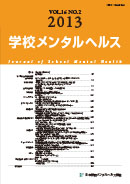Objective: At schools where children have various issues that need to be addressed, an impasse can result when the school seeks to provide them with assistance, because of difficulties in responding to them and their guardians, including the initial response. Such a situation can become serious. This study reports on various cases in which a school counselor intervened to assist students and the situation reached an impasse. The study aims to examine the role of the school counselor by qualitatively investigating the factors that contribute to an impasse.
Methods: Various obvious case examples of assistance to students that reach an impasse were extracted. The subjects were school children/students who attend public elementary, middle, or high schools, and guardians and teachers. These case examples were outlined.
Results: An examination of the five case examples suggested that the factors that led to an impasse in assisting students were their rejection of and rebellion against help, the guardian’s passivity and uncooperativeness, and factors related to the school. Furthermore, the impetuses for overcoming an impasse were the identification of the problem and intervention by a third party (i.e., school counselors).
Discussion: The study showed that teachers who have heightened negative emotion to the extent that they cannot examine the internal conflict behind children’s behaviors, such as rejecting and rebelling, can increase the risk that assistance will reach an impasse. Therefore, it is necessary to flexibly respond to guardians who are difficult to handle by approaching them from the perspective of offering team-based assistance. Furthermore, the study suggested that when the school administration becomes exhausted, an impasse in assistance is likely to occur. Furthermore, the study examined a method of psychological assistance by which a school counselor can change a situation for the better by evaluating an impasse through judging it objectively.
View full abstract
